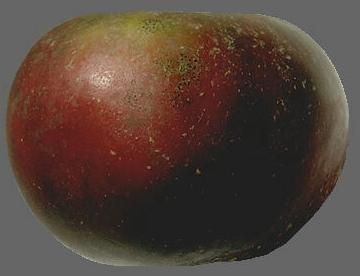(401)766-6533 or Toll Free (877) 203-4726
Please call for Pick Your Own schedules
and for variety availability.
|
Lodi (July: Week 1) An very early season apple, Lodi retains the quality and flavor of Yellow Transparent. A thick yellow skin covers this crisp, very tart tasting apple, which is excellent for pies, but does not store well.
|
||
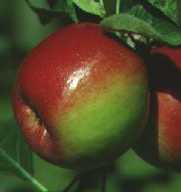 |
Red Free (Summer Red) (July: Week 4) This apple is of medium size, with glossy bright red color. The skin is smooth, and the light flesh is crisp and juicy. Excellent flavor. This variety was introduced in 1981.
|
|
|
Paula Red (August: Week 2) This apple is well suited not only for fresh eating but for cooking. The apple has the pleasing tartness of McIntosh and a rather similar appearance with a red blush over a yellow-green background. It is a short-season apple typically available through early October. This apple was bred by Nature, not man. The Paula Red is considered a McIntosh mutation, discovered around 1960 near a McIntosh block by grower Lewis Arends of Sparta, Michigan, who named the new variety after his wife Pauline.
|
||
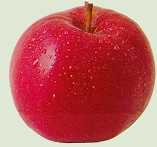 |
Ida Red (August: Week 3)
Ida Red's flavor is tangy and tart. Besides its excellence as a fresh apple, it is widely used in sauces and pies and in baking it can be relied on to retain its shape. It's a bright red apple that is firm and keeps well. The Ida Red is a cross of Jonathan with Wagener and was made at the Idaho Agricultural Experiment Station and released commercially in 1942.
|
|
|
|
Priscilla (August: Week 3) This apple's parent is Starking Delicious. Medium in size, the skin blushes red over yellow background. The flesh is crisp, coarse, and of a white to slightly greenish color. It has good flavor and quality, and will store for three months.
|
|
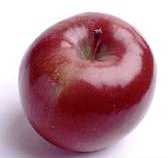
|
McIntosh (August: Week 4) McIntosh has juicy white flesh and a rather tough skin that has mixed red and green coloring. It's a favorite apple for eating but also is widely used in salads and sauces and pies, and is a mainstay in fresh cider. The story of this variety is interesting. In 1796 John McIntosh, a 19-year-old from the Mohawk Valley in New York, was smitten with a young woman, but faced with strong opposition to the romance from his father, the couple hatched a plan to elope to Canada. John's bride-to-be left first, and he soon followed, but by the time he caught up to her, he found she had died of a sudden illness. Devastated, he hiked off into the Canadian wilderness to become a hermit. Emerging from his seclusion five years later John homesteaded near Dundela, Ontario, not far from the St. Lawrence River. There he found and transplanted some wild apple saplings, one of which survived to produce fruit so tangy and aromatic that it became well known in the region. Years later it was propagated commercially by John McIntosh's son, whence it became known as McIntosh Red. The variety is thought to be related to the Fameuse apple of the region. Fameuse (Snow Apple): One of the oldest and most desirable dessert apples. Grown by 1730 on the shores of Lake Champlain, this apple was brought to Canada from France. Its pure white flesh, sometimes streaked with red from the dark red skin, is juicy and refreshing eaten out of hand.
|
|
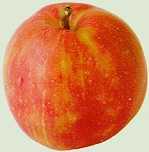 |
Gravenstein (August: Week 2) This medium to large, round, apple appears red blushed with yellow background. Its flesh is cream colored, juicy, and tart. Excellent for pies, fresh eating, sauce and freezing, it is also good in salads and baking.
|
|
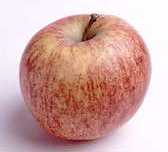 |
Gala (August: Week 3) This apple is a relatively early variety that has a snappy zest over a mellow sweetness. Its yellowish, juicy flesh is very firm. Galas are noted for their eating quality out of hand. It was bred in New Zealand and released in 1960, its parents Kidd's Orange Red and Golden Delicious. It was brought to the United States in 1972 by Stark Brothers Nurseries & Orchards Co. of Louisiana, Missouri. The original Galas retained the external color from the Kidd's side, but some mutations found recently show a complete red color.
|
|
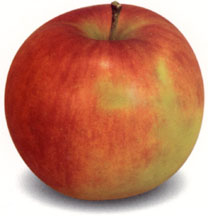 |
Jonagold (August: Week 4) An excellent all-purpose apple that is firm and juicy with appealing shades of flavors from tart to sweet. It is a cross of Jonathan and Golden Delicious. The latter contributes a yellow background to Jonagold, while its Jonathan parentage adds an orange-red blush. Some newer "sports" or mutations are predominantly red.
|
|
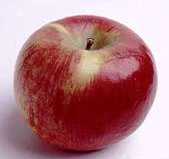 |
Cortland (August: Week 4) This apple has very white flesh and is an excellent dessert apple. Its flavor is sweet compared to McIntosh, and it has a flush of crimson against a pale yellow background sprinkled with short, dark red stripes and gray-green dots. Cortland is the result of a crossing of McIntosh with Ben Davis variety and it was introduced early this century.
|
|
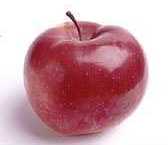 |
Empire (Sept: Week 1) Empire is excellent for eating, in salads, and for use in baking and cooking. It combines the mild tartness of McIntosh with full-flavored Red Delicious sweetness. A cross between McIntosh and Red Delicious, it takes on the best characteristics of both. It is redder and firmer than McIntosh, and because it stores longer it provides the marketplace with a McIntosh-type apple well into the spring.
|
|
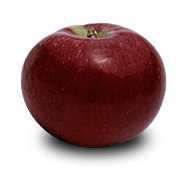 |
Macoun (Sept: Week 2) This favorite East Coast apple is small to medium-size and wine red in color. It is crisp, juicy and sweetly tart. The Macoun is considered an all-purpose apple, but is especially good for eating out of hand.
|
|
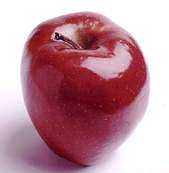 |
Red Delicious (Sept: Week 2) A glossy red apple with a distinctive five-pointed elongated shape familiar to almost every apple eater. It's best eaten fresh rather than cooked and offers a juicy and crunchy texture and a sweet flavor. Red Delicious originated in a non-apple region: central Iowa. A farmer named Jesse Hiatt discovered the chance seedling on his farm near Peru, Iowa, and twice tried to chop it out. When it sprouted a third time, he gave it a reprieve and let it grow. Later he discovered qualities in it he liked, and he displayed it as the Hawkeye variety at an 1893 fruit show in Louisiana, Missouri. The sponsors of the show were Stark Brothers Nurseries & Orchards Co., and they purchased propagating rights in 1894, renaming it Delicious, which is still its official name although it is popularly known as Red Delicious to distinguish it from Golden Delicious.
|
|
 |
Liberty (Sept: Week 2) Most disease resistant apple ever developed, it was achieved by crossing Macoun and Purdue 54-12. This apple is a medium to large, bright, shiny, McIntosh-type fruit with a red blush, and crisp, juicy, light yellow flesh. It has a sprightly flavor. Good for eating fresh, cooking, canning or desserts, it stores until February, and its flavor intensifies in storage.
|
|
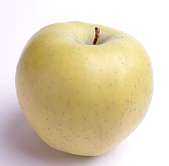 |
Golden Delicious (Sept: Week 3) A sweet apple requiring little added sugar in cooking uses, such as sauce, pie and baking, where its firmness helps hold its shape. It also has excellent flavor when eaten fresh. It's a popular inclusion in fresh apple cider. Golden Delicious was discovered as a chance seedling in Clay County, West Virginia, in 1914 and was named Mullin's Yellow Seedling. Stark Brothers bought propagation rights and renamed it Golden Delicious as a companion to (Red) Delicious, to which it is not related genetically. The parentage of Golden Delicious is thought to be Golden Reinette and Grimes Golden.
|
|
|
RI Greening (Sept: Week 3) This medium-size, green to yellow green apple has a sweet-tart flavor that seems to intensify when cooked. Because both texture and flavor hold up to heat, it is excellent in applesauce and pies, and it's also good for out-of-hand eating. A variant grown in the western half of the country is called Northwest Greening.
|
||
 |
Crispin or Mutsu (Oct: Week 1) This apple is typically greenish on the outside and creamy white on the inside with firm-textured juicy flesh. It has a moderately sweet flavor, and is an excellent eating or pie apple. As its alternative name suggests, Crispin has Japanese origins. This 1930 cross of Golden Delicious and the Japanese variety Indo was named Mutsu upon its 1949 release. It was renamed Crispin in 1968 in the United Kingdom, and New York adopted that name several years ago. It is one of the later varieties, and does double duty as a fresh apple and a processing apple.
|
|
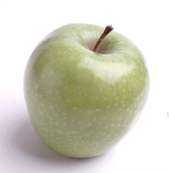 |
Granny Smith (Oct: Week 4) Great for retaining its flavor during cooking, the Granny Smith is also a refreshingly zesty eating apple that was cultivated by a real grandmother, named Smith, in nineteenth century New Zealand. A very tart apple, it mellows in flavor during winter and spring months.
|
|
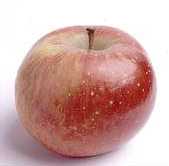 |
Fuji (Oct: Week 4) This variety resulted when Ralls Janet was crossed with Red Delicious, and produced an apple of yellowish green skin with an orangish red flush (deeper blush on sun side) and darker stripes. A crisp, juicy fruit, the it has slightly subacid white flesh with outstanding texture, which keeps well. It is an excellent eating, dessert, and salad apple. It was developed in Japan and introduced in 1962, and has since become Japan's number one variety. It ripens very late, and has very long storage life.
|
|
|
Apple Links Thomas Jefferson's Apple Orchard Johnny Appleseed Trail
|

|

|

|
||
| Home | Halloween | Produce |
